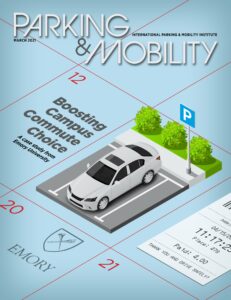 Parking payment technology has advanced from the spare change in your wallet to an app on your phone hosted in the cloud. Digital parking apps and services provide ease and convenience to both parties to a digital parking transaction. However, while feeding quarters in a parking meter is a rather anonymous transaction, the use of a digital platform for a parking transaction requires a user to provide, and a company to store, personal and financial information of its users. This creates a duty for parking technology providers to properly secure and safeguard highly-valuable, protected personally identifiable information.
Parking payment technology has advanced from the spare change in your wallet to an app on your phone hosted in the cloud. Digital parking apps and services provide ease and convenience to both parties to a digital parking transaction. However, while feeding quarters in a parking meter is a rather anonymous transaction, the use of a digital platform for a parking transaction requires a user to provide, and a company to store, personal and financial information of its users. This creates a duty for parking technology providers to properly secure and safeguard highly-valuable, protected personally identifiable information.
In the digital realm, protected personally identifiable information (PII) includes names, license plate numbers, email addresses, phone numbers, vehicle nicknames, passwords, and home addresses. Hackers and digital scammers spend a lot of time and effort attempting to infiltrate digital platforms to steal PII for criminal enterprise, resulting in billions of dollars of losses due to identity theft and fraud. The failure to properly secure customer PII can create liability to a digital service provider for reckless or negligent disclosure.
Michael J. Ash, Esq., CRE, partner with Carlin & Ward, shares the potential pitfalls and liabilities of personally identifiable data and some great tips for avoiding them, in this month’s Parking & Mobility magazine. Click here to read the whole article.

 By Kevin White, CAPP, AICP
By Kevin White, CAPP, AICP By Brett Wood, CAPP, PE
By Brett Wood, CAPP, PE “Data” is definitely one of the words of the year in parking and mobility. From curb management to contactless payments to right-sizing parking to nearly every step forward, we hear a lot about it all being fueled by data. And we all know the truth: It’s fairly easy to collect data. It’s much more difficult to know the best way to compile, analyze, and use it–much less choose which data points really matter–to make future-forward decisions.
“Data” is definitely one of the words of the year in parking and mobility. From curb management to contactless payments to right-sizing parking to nearly every step forward, we hear a lot about it all being fueled by data. And we all know the truth: It’s fairly easy to collect data. It’s much more difficult to know the best way to compile, analyze, and use it–much less choose which data points really matter–to make future-forward decisions. By Meera Raja
By Meera Raja Matthew Hulme, CAPP, MPA
Matthew Hulme, CAPP, MPA By Kevin White, AICP
By Kevin White, AICP By Melonie Curry, MBA
By Melonie Curry, MBA By Nathan Donnell, CAPP
By Nathan Donnell, CAPP We see on-street parking competition from transit, bicycles, online shopping delivery trucks, shared mobility service companies, and a variety of other usages. People love convenience, but the rigid, daily demand for on-street parking has consequences, including double parking.
We see on-street parking competition from transit, bicycles, online shopping delivery trucks, shared mobility service companies, and a variety of other usages. People love convenience, but the rigid, daily demand for on-street parking has consequences, including double parking.